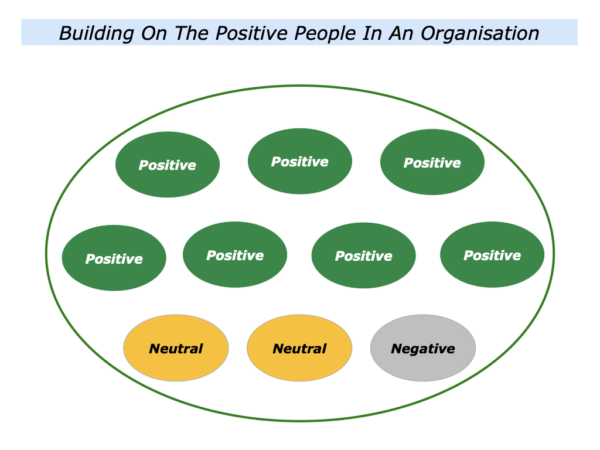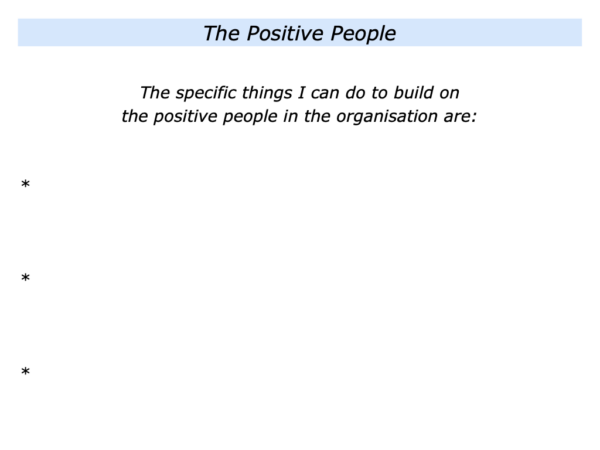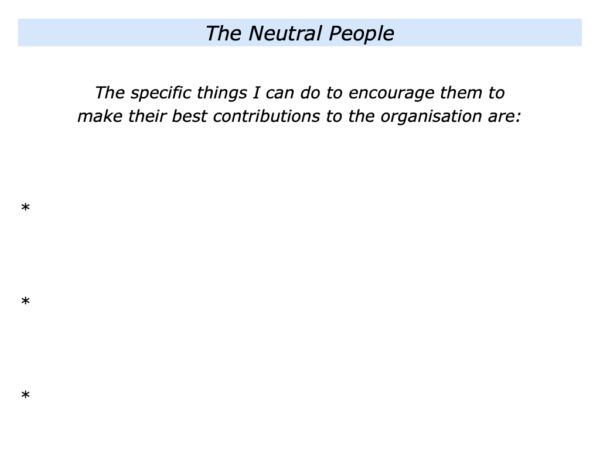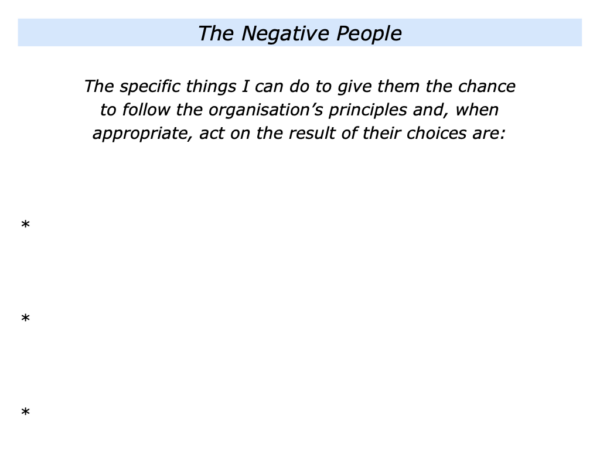
Imagine that you lead an organisation. Some of the people are positive, some are neutral, some are negative. How do you want to work with the different kinds of people?
In the old days organisations often told you to concentrate on turning around the negative people. But that did not work. Nowadays you put your energy into the engine, not the trailer.
Good leaders often believe in giving their people the big picture. They then enable people to make their best contributions to achieveing the organisation’s goals. Some do this by taking the following steps.
They communicate the organisation’s purpose, principles and picture of success;
They build on the positive people whilst also giving everybody the chance to contribute to achieving the picture of success;
They encourage people to do superb work and do their best to help the organisation achieve its picture of success.
Such leaders believe it is important to be moral and give everybody the big picture. People can then decide if they want to opt in and help to deliver the goals.
Imagine that you have gone through this stage. Looking around, it has become apparent that people are choosing either:
To be positive and professional … To be neutral or guarded … To be negative or unprofessional.
Let’s explore how you can work with the different kinds of people. You will, of course, adapt these approaches in your own way.
The Positive People
“Reward the behaviour you want repeated,” is the motto in all organisations. Bearing this in mind, it is important to encourage the positive people who aim to deliver high professional standards.
Such people are the engine but they also need support. They frequently volunteer for tasks and do fine work but they also get exhausted. Bearing this in mind, you can aim:
To spend time these people, build on their strengths and make clear contracts about their best contributions to the organisation;
To encourage them to follow the organisations principles, agree on the outcomes they will deliver and provide them with the required support;
To enable them to perform superb work that contributes to achieving the organisation’s picture of success.
One soccer manager I worked with took this approach. Taking over an under-achieving club at the end of a season, he was appalled by the attitudes of some players. He chose:
To bring in four senior professionals who acted as positive models;
To build on the players who were prepared to act in a professional way;
To replace the negative ones with young players from the academy.
The manager produced an immediate culture change that was reflected both on and off the field. The team climbed the league and the next season went on to win its first national trophy.
Imagine that you lead an organisation. How can you build on the positive people? How can you encourage them to make their best contributions? How can you give them support and help them to achieve success?
If you wish, try tackling the exercise on this theme. This invites you to complete the following sentence.

The Neutral People
Some people may be neutral or guarded. There can be many reasons for their behaviour. They may have seen new leaders come in, make big promises and fail to deliver. This can explain why they are guarded.
Such people can be professional and make fine contributions. They must each make their own decisions, of course, but there are many things you can do to provide an encouraging environment.
One approach is to spend time with these people by meeting them in groups or in one-to-one sessions. You can then aim:
To again share the organisation’s purpose, principles and picture of success;
To give them a sense of ownership – within certain parameters – in following the principles when working towards the picture of success;
To give them the support they need to perform superb work on the way towards achieving the picture of success.
Different leaders follow this approach in different ways. One leader who took over the European arm of a multinational company explained how they took these steps.
“I toured every country in the European region and did two-hour sessions in which I literally met every person.
“Meeting groups of around twenty people, I talked about last year’s achievements, before outlining the goals for the next year.
“I used a flip chart and a few slides, but the tone was mainly conversational. Looking at the challenges ahead, I invited people to ask their questions and answered these as honestly as possible.
“Finally I reiterated the organisation’s strategy and outlined what we could all do to get some quick successes. People seemed to appreciate the sessions.”
Sounds hard work? Perhaps, but it can be harder if leaders do not connect with people. Given the right kind of support, many will do superb work and go that extra mile.
Another approach is to have one-to-one sessions with people. This is often more suitable when taking over a relatively small team because of the numbers involved.
You can meet with the individuals and again explain the organisation’s purpose, principles and picture of success. You can then invite them to take time to reflect about their contribution.
If appropriate, you can make clear contracts about: a) the specific contribution they will make; b) the specific support they need; c) the specific things they will do to keep you informed about their progress.
Imagine that you lead an organisation. How can you encourage the neutral people? This may or may not work, but it can increase the chances of them making their best contribution.
If you wish, try tackling the exercise on this theme. This invites you to complete the following sentence.

The Negative People
People who are negative or unprofessional need to make a decision. Do they want to follow the organisation’s principles and make a positive contribution?
Different leaders invite people to make these decisions in different ways. They do not get into arguments with people. They simply say something along the following lines.
“The principles we encourage the people in our organisation to follow are: To … To … To …
“The reasons for following these principles are because we aim: To … To … To …
“Looking to the future, let me know if you want to follow these principles.
“If so, then we can look together at how you can take these steps and help the organisation to achieve success. If not, then we can have a discussion about the possible ways forward.”
Some individuals may want to argue, blame others or fight dirty. As mentioned earlier, however, good leaders do not get into arguments. They simply keep saying:
“These are the principles we want people to follow. Let me know if you want to follow these in a professional way.”
Sometimes a person will say they want to follow the principles but they need to follow up with deeds not just words. If appropriate, you can then invite the person to create a specific action plan. The person can describe:
The specific principles they aim to follow that will help the organisation to achieve success;
The specific things they will do to translate these principles into action and deliver success;
The specific other things they will do in the future to help their colleagues and the organisation to achieve success.
At this point it is worth doing a reality check. Some individuals may say they want to commit but not translate their words into action. They have made their choice and there will be consequences.
Imagine that you lead an organisation. You want to build on the positive people and give the neutral people the chance to make their best contributions.
You are also prepared to replace any negative people with people who want to follow the principles. These new people can then add to the positive energy and help the organisation to achieve success.
If you wish, try tackling the final exercise on this theme. This invites you to describe the specific things you can do to give any negative people the chance to follow the principles and then to act on the result of their choices.







Leave a Reply